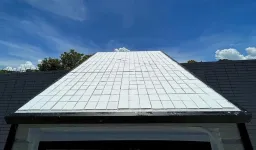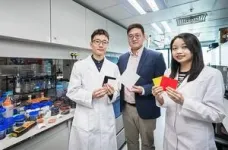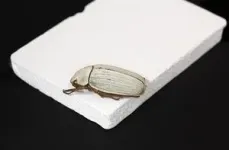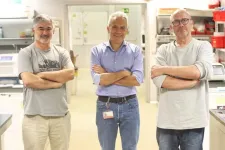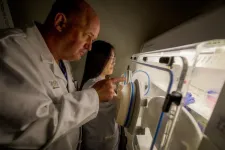(Press-News.org) A significant breakthrough in developing a passive radiative cooling (PRC) material has been announced by researchers at City University of Hong Kong (CityU). The findings have just been published in the prestigious scientific journal Science titled “Hierarchically structured passive radiative cooling ceramic with high solar reflectivity.”
The material, known as cooling ceramic, has achieved high-performance optical properties for energy-free and refrigerant-free cooling generation. Its cost-effectiveness, durability and versatility make it highly suitable for commercialisation in numerous applications, particularly in building construction.
By reducing the thermal load of buildings and providing stable cooling performance, even in diverse weather conditions in all climates, cooling ceramic enhances energy efficiency and can combat global warming.
PRC is considered one of the most promising green cooling technologies for curbing soaring demand for space cooling, reducing environmental pollution, and combating global warming, according to Professor Edwin Tso Chi-yan, Associate Professor in the School of Energy and Environment (SEE) at CityU, one of the corresponding authors of the paper.
However, current PRC using nanophotonic structures are limited by its high cost and poor compatibility with existing end uses, while polymeric photonic alternatives lack weather resistance and effective solar reflection.
Enhanced optical properties and applicability
“But our cooling ceramic achieves advanced optical properties and has robust applicability,” said Professor Tso. “The colour, weather resistance, mechanical robustness and ability to depress the Leidenfrost effect – a phenomenon that prevents heat transfer and makes liquid cooling on the hot surface ineffective – are key features ensuring the durable and versatile nature of the cooling ceramic.”
The cooling ceramic's extraordinary uniqueness lies in its hierarchically porous structure as a bulk ceramic material, which is easily fabricated using highly accessible inorganic materials such as alumina through a simple two-step process involving phase inversion and sintering. No delicate equipment or costly materials are required, making scalable cooling ceramics manufacturing highly feasible.
Optical properties determine the cooling performance of PRC materials in two wavelength ranges: solar range (0.25-2.5 µm) and mid-infrared range (8-13 µm). Efficient cooling requires high reflectivity in the former range to minimise the solar heat gain and high emissivity in the latter range to maximise the radiative heat dissipation. Owing to the high bandgap of alumina, the cooling ceramic keeps solar absorption to a minimum.
Not only that, by mimicking the bio-whiteness of the Cyphochilus beetle and optimising the porous structure based on Mie scattering, the cooling ceramic efficiently scatters almost all the wavelength of sunlight, resulting in near-ideal solar reflectivity of 99.6% (a recorded high solar reflectivity) and achieves a high mid-infrared thermal emission of 96.5%. These advanced optical properties surpass those of current state-of-the-art materials.
“The cooling ceramic is made of alumina, which provides the desired UV resistance degradation, which is a concern typical of most polymer-based PRC designs. It also exhibits outstanding fire resistance by withstanding temperatures exceeding 1,000°C, which surpasses the capabilities of most polymer-based or metal-based PRC materials,” said Professor Tso.
Outstanding weather resistance
Beyond its exceptional optical performance, the cooling ceramic exhibits excellent weather resistance, chemical stability and mechanical strength, making it ideal for long-term outdoor applications. At extremely high temperatures, the cooling ceramic exhibits superhydrophilicity, enabling immediate droplet spreading, and facilitating rapid impregnation of the droplets due to its interconnected porous structure. This superhydrophilic characteristic inhibits the Leidenfrost effect that hinders evaporation, commonly found in traditional building envelope materials, and enables efficient evaporative cooling.
The Leidenfrost effect is a phenomenon that occurs when a liquid is brought into contact with a surface significantly hotter than its boiling point. Instead of immediately boiling away, the liquid forms a vapour layer that insulates it from direct contact with the surface. This vapour layer reduces the rate of heat transfer and makes liquid cooling on the hot surface ineffective, causing the liquid to levitate and skid across the surface.
“The beauty of the cooling ceramic is that it fulfils the requirements for both high-performance PRC and applications in real-life settings,” said Professor Tso, adding that the cooling ceramic can be coloured with a dual-layer design, meeting aesthetic requirements as well.
“Our experiment found that applying the cooling ceramic on a house roof can achieve more than 20% electricity for space cooling, which confirms the great potential of cooling ceramic in reducing people’s reliance on traditional active cooling strategies and provides a sustainable solution for avoiding electricity grid overload, greenhouse gas emissions and urban heat islands,” said Professor Tso.
Based on these findings, Professor Tso said the research team intends to advance further passive thermal management strategies. They aim to explore the application of these strategies to enhance energy efficiency, promote sustainability, and increase the accessibility and applicability of PRC technologies in various sectors, including textiles, energy systems, and transportation.
Professor Wang Zuankai, Adjunct Professor in the Department of Mechanical Engineering (MNE) at CityU and Associate Vice-President (Research and Innovation) at the Hong Kong Polytechnic University, is the other corresponding author. The first author, Lin Kaixin, and the second author, Chen Siru, are both PhD students supervised by Professor Tso in CityU's School of Energy and Environment.
https://www.cityu.edu.hk/research/stories/2023/11/10/new-cooling-ceramic-can-enhance-energy-efficiency-construction-sector-and-help-combat-global-warming-cityu-research
END
New cooling ceramic can enhance energy efficiency for the construction sector and help combat global warming—City University of Hong Kong research
2023-11-10
ELSE PRESS RELEASES FROM THIS DATE:
CNIC scientists identify the crucial role of the protein neuregulin-1 in heart development
2023-11-10
In a study published in the journal Circulation Research, researchers at the Centro Nacional de Investigaciones Cardiovasculares (CNIC) led by Dr. José Luis de la Pompa reveal the essential role of the protein neuregulin-1 (Nrg1) in the intricate transformation of the heart from its delicate primordial structure into a powerful pumping organ.
The findings not only highlight the pathways through which the human heart forms, but also suggest important directions for future medical advances. Commenting on the study, Dr. de la Pompa, head of the ...
Bullying victims who perceive they’re targeted due to social characteristics feel the effects worse, new research suggests
2023-11-10
Students who feel they have been victimized because of social characteristics such as their ethnicity or their sexuality are at additional risk of trauma, a new national US study has revealed.
Published in the peer-reviewed Journal of School Violence, the research, of more than 2,200 young victims of bullying, found students reported that their physical health; self-esteem; social relationships, and schoolwork suffered more if they felt bias was behind the perpetrators’ actions.
This was particularly ...
Any activity is better for your heart than sitting – even sleeping
2023-11-10
The study, supported by the British Heart Foundation (BHF) and published in the European Heart Journal, is the first to assess how different movement patterns throughout the 24-hour day are linked to heart health. It is the first evidence to emerge from the international Prospective Physical Activity, Sitting and Sleep (ProPASS) consortium.
Cardiovascular disease, which refers to all diseases of the heart and circulation, is the number one cause of mortality globally. In 2021, it was responsible for one in three ...
Health: Lack of friend or family visits is associated with increased risk of dying
2023-11-10
Never being visited by friends or family is associated with an increased risk of dying, according to a study published in BMC Medicine. The authors suggest that their findings could be used to help identify patients at a higher risk of dying due to social factors, and to develop more effective interventions to combat the increased risk of death associated with social isolation.
Although previous research has identified associations between deaths due to any causes and both a ‘sense of loneliness’ and living alone, the combined impacts of different types of social interaction ...
Aid agencies are failing patients with breast cancer in war zones meaning more will develop advanced disease
2023-11-10
Lisbon, Portugal: Patients with breast cancer in conflict zones around the world are being “massively under-served” by governments, UN aid agencies and other non-governmental organisations (NGOs), Professor Richard Sullivan told the Advanced Breast Cancer Seventh International Consensus Conference (ABC 7). [1]
Among people fleeing conflict zones, either displaced within their own country or across borders to other countries, patients with breast cancer are the “single largest group of cancer patients that present to UN agencies and international NGOs,” said Prof. Sullivan, who is director of the Institute of Cancer Policy and co-director of the Centre for ...
Is the US reporting system for vaccine safety broken?
2023-11-10
Is the US reporting system for vaccine safety broken?
Investigation raises concerns that the system is not operating as intended and signals are being missed
A US reporting system designed to detect potential safety issues with vaccines is supposed to be user-friendly, responsive, and transparent. But an investigation published by The BMJ today finds it’s not meeting its own standards.
The Vaccine Adverse Event Reporting System (VAERS), co-managed by the US Centers for Disease Control and Prevention (CDC) and the Food and Drug Administration (FDA), collects reports of symptoms, ...
Gut bacteria protects against diarrhoeal disease
2023-11-10
Gut bacteria protects against diarrhoeal disease
Peer reviewed - Systematic review – people and animals
The severity of a diarrhoeal disease could be down to the bacteria in your gut – according to new research from the University of East Anglia.
Cryptosporidiosis is responsible for over 100,000 deaths annually – predominantly in children under five.
It also affects animals, and a new study published today shows that large animals – including primates - with less different ...
Found at last: Bizarre, egg-laying mammal finally rediscovered after 60 years
2023-11-10
A long-beaked echidna named after Sir David Attenborough and last seen by scientists in 1961 has been photographed for the first time in an Indonesian tropical forest.
An international team of researchers worked with local communities to deploy over 80 camera traps to film the elusive animal.
Besides rediscovering the echidna, the team uncovered a wealth of species completely new to science, including beetles, spiders, and a remarkable tree-dwelling shrimp.
A wide range of images and video footage from the expedition are available (see link below).
More than sixty years after it was last recorded, an expedition ...
WHO updates its guidance on treatments for COVID-19
2023-11-10
A panel of international experts representing the World Health Organization’s Guideline Development Group has updated its guidance on treatments for patients with covid-19.
The new recommendations published by The BMJ are part of a living guideline, developed by the World Health Organization with the methodological support of MAGIC Evidence Ecosystem Foundation, to provide up to date, trustworthy guidance on the management of covid-19 and help doctors make better decisions with their patients.
The guidance ...
UTHealth Houston researchers awarded $2.6 million NIH grant to study molecular pathways and potential strategies for treatment of myocardial ischemia and reperfusion injury
2023-11-10
A four-year, $2.6 million grant to study circadian rhythm and novel therapies to protect the heart during a heart attack or cardiac surgery has been awarded to UTHealth Houston by the National Heart, Lung, and Blood Institute, part of the National Institutes of Health.
Principal investigator Holger Eltzschig, MD, PhD, professor, and co-investigator Wei Ruan, MD, PhD, assistant professor, from the Department of Anesthesiology, Critical Care and Pain Medicine at McGovern Medical School at UTHealth Houston, are studying translational, pharmacologic, and interventional strategies targeting ...
